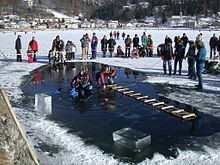 Global Information
Global InformationList of diving environments by type information

The diving environment is the natural or artificial surroundings in which a dive is done. It is usually underwater, but professional diving is sometimes done in other liquids. Underwater diving is the human practice of voluntarily descending below the surface of the water to interact with the surroundings, for various recreational or occupational reasons, but the concept of diving also legally extends to immersion in other liquids, and exposure to other pressurised environments.[1] Some of the more common diving environments are listed and defined here.
The diving environment is limited by accessibility and risk, but includes water and occasionally other liquids. Most underwater diving is done in the shallower coastal parts of the oceans, and inland bodies of fresh water, including lakes, dams, quarries, rivers, springs, flooded caves, reservoirs, tanks, swimming pools, and canals, but may also be done in large bore ducting and sewers, power station cooling systems, cargo and ballast tanks of ships, and liquid-filled industrial equipment. The environment may affect equipment configuration: for instance, freshwater is less dense than saltwater, so less added weight is needed to achieve diver neutral buoyancy in freshwater dives.[2] Water temperature, visibility and movement also affect the diver and the dive plan.[3] Diving in liquids other than water may present special problems due to density, viscosity and chemical compatibility of diving equipment, as well as possible environmental hazards to the diving team.[4]
Benign conditions, sometimes also referred to as confined water, are environments of low risk, where it is extremely unlikely or impossible for the diver to get lost or entrapped, or be exposed to hazards other than the basic underwater environment. These conditions are suitable for initial training in the critical survival skills, and include swimming pools, training tanks, aquarium tanks and some shallow and protected shoreline areas.[5]
Open water is unrestricted water such as a sea, lake or flooded quarry, where the diver has unobstructed direct vertical access to the surface of the water in contact with the atmosphere.[6] Open-water diving implies that if a problem arises, the diver can directly ascend vertically to the atmosphere to breathe air.[7] Wall diving is done along a near vertical face. Blue-water diving is done in mid-water where the bottom is out of sight of the diver and there may be no fixed visual reference.[8] Black-water diving is mid-water diving at night, particularly on a moonless night.[9][10]
An overhead or penetration diving environment is where the diver enters a space from which there is no direct, purely vertical ascent to the safety of breathable atmosphere at the surface. Cave diving, wreck diving, ice diving and diving inside or under other natural or artificial underwater structures or enclosures are examples. The restriction on direct ascent increases the risk of diving under an overhead, and this is usually addressed by adaptations of procedures and use of equipment such as redundant breathing gas sources and guide lines to indicate the route to the exit.[11][4][3]
Night diving can allow the diver to experience a different underwater environment, because many marine animals are nocturnal.[12] Altitude diving, for example in mountain lakes, requires modifications to the decompression schedule because of the reduced atmospheric pressure.[13][14]
- ^ Cite error: The named reference
SA Diving Regulations 2009was invoked but never defined (see the help page). - ^ Cite error: The named reference
Graver2010was invoked but never defined (see the help page). - ^ a b Cite error: The named reference
Jablonski 2006was invoked but never defined (see the help page). - ^ a b Cite error: The named reference
High riskwas invoked but never defined (see the help page). - ^ Cite error: The named reference
CoP Benignwas invoked but never defined (see the help page). - ^ Cite error: The named reference
Aus Part 3was invoked but never defined (see the help page). - ^ Cite error: The named reference
Divers dictionarywas invoked but never defined (see the help page). - ^ Cite error: The named reference
Haddock and Heinewas invoked but never defined (see the help page). - ^ Cite error: The named reference
Black-waterwas invoked but never defined (see the help page). - ^ Cite error: The named reference
Indigowas invoked but never defined (see the help page). - ^ Cite error: The named reference
CoP Scientificwas invoked but never defined (see the help page). - ^ Cite error: The named reference
BSACwas invoked but never defined (see the help page). - ^ Cite error: The named reference
Jackson 2000was invoked but never defined (see the help page). - ^ Cite error: The named reference
USNDM R6was invoked but never defined (see the help page).